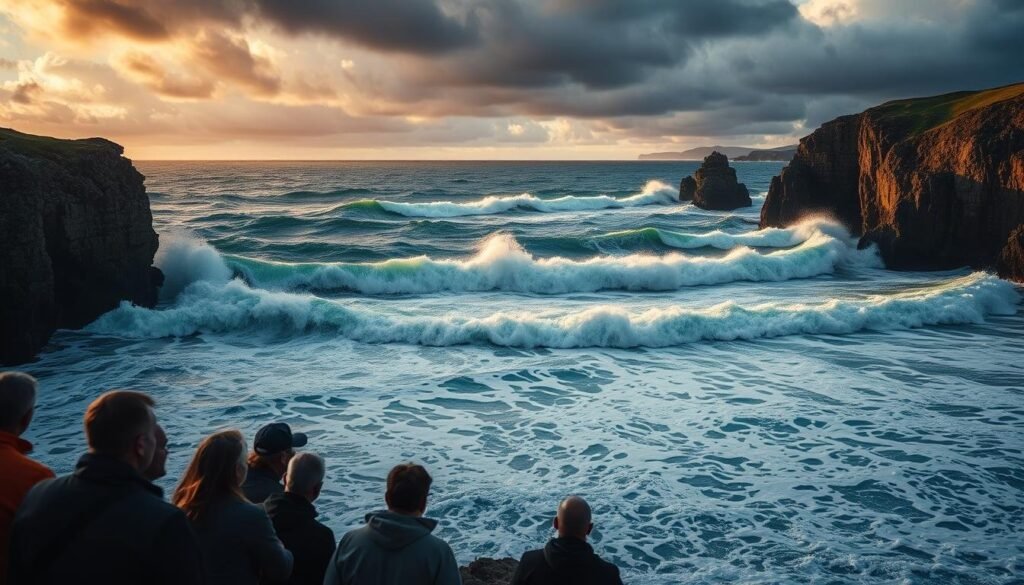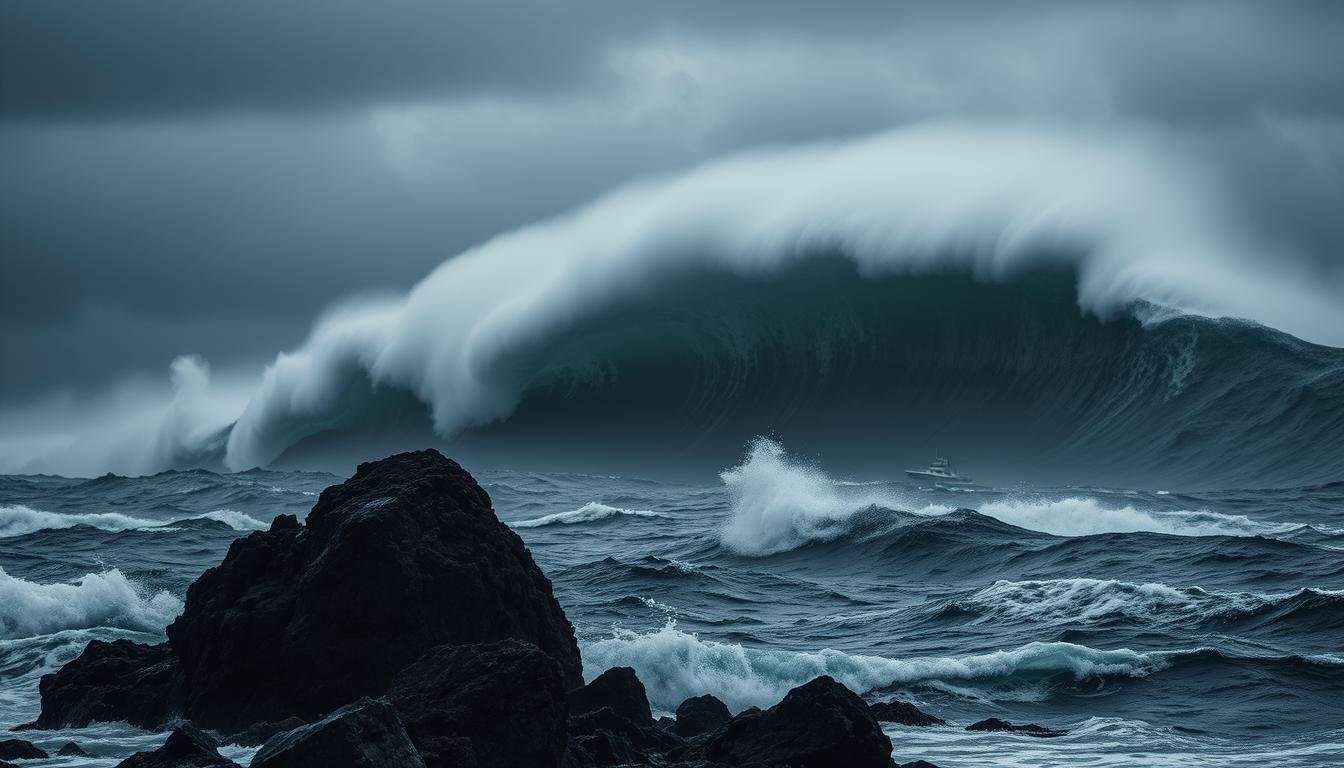Why Square Waves in the Ocean Can Be Dangerous? Have you ever thought about the dangers of certain ocean waves? Square waves, or cross-sea waves, can be very dangerous. They can create strong rip currents that make swimming hard or even pull you out to sea.
It’s important to know about these ocean dangers to stay safe. When you’re at the beach, knowing what to watch out for can help you stay safe. Rip currents, for example, can be deadly if you’re not ready.
We’ll dive deeper into what causes square waves and how to spot dangers. Knowing this can help you enjoy the ocean safely and avoid these risks.
Contents
- 1 What Are Square Waves in the Ocean?
- 2 How Square Waves Form in the Ocean
- 3 Why Are Square Waves in the Ocean Dangerous?
- 4 Risks to Swimmers and Surfers
- 5 Dangers to Boats and Maritime Vessels
- 6 How to Identify Square Waves from Shore
- 7 Safety Precautions and Survival Techniques
- 8 Staying Safe Around Square Waves
- 9 FAQ: Why Square Waves in the Ocean Can Be Dangerous?
- 9.1 What are square waves in the ocean?
- 9.2 How do square waves form in the ocean?
- 9.3 Are square waves dangerous to swimmers and surfers?
- 9.4 Can square waves cause accidents to boats and maritime vessels?
- 9.5 How can you identify square waves from the shore?
- 9.6 What safety precautions can you take when encountering square waves?
- 9.7 What is the “swimming parallel to shore” technique?
- 9.8 Are there any famous locations around the world known for square waves?
What Are Square Waves in the Ocean?
You might have seen pictures or videos of ocean waves with a unique checkerboard pattern. This pattern is called square waves. They form when two wave systems meet at right angles, creating a grid-like pattern on the water’s surface.
Checkerboard Pattern on Water Surface
The square waves have a distinctive checkerboard or grid-like look. This happens when two wave systems interact, often due to changing winds or ocean currents. Unlike regular waves, square waves have a more complex and irregular shape.
| Characteristics | Square Waves | Regular Waves |
|---|---|---|
| Pattern | Checkerboard or grid-like | Smooth, continuous |
| Formation | Intersection of two wave systems | Single wave system |
| Appearance | Complex, irregular | Uniform, predictable |
Understanding square waves helps us appreciate the ocean’s complexity. It also shows the dangers they can pose to swimmers, surfers, and ships.
How Square Waves Form in the Ocean
Understanding how square waves form in the ocean is key to seeing their power and danger. Square waves happen when two wave systems meet at an angle, usually between 60 and 120 degrees. This creates a grid-like pattern on the water’s surface. This usually happens because of changing weather or ocean currents that change wave directions.
Ocean currents play a big role in making square waves. They can make waves change direction, leading to the crossing patterns seen in square waves. When these waves meet, they create a unique and dangerous sea state.
Famous Square Wave Locations Around the World
Some of the world’s most famous square wave spots are in France, especially around Ré island. The United States also has famous beaches in California where square waves can be found. These places have unique geography that helps create the perfect conditions for square waves.
Visiting these spots can be exciting for surfers and beach lovers. But, it’s important to know the dangers of square waves.
Why Are Square Waves in the Ocean Dangerous?
Square waves in the ocean are dangerous because they can create strong rip currents. It’s important to know the risks when you’re in the water.
Square waves, or cross seas, happen when two wave systems meet at an angle. This creates a grid-like pattern on the water’s surface. These waves can form powerful rip currents that pull you away from the shore or your boat.
The Science Behind Rip Currents in Cross Seas
Rip currents are strong water channels that flow away from the shore. They often form through breaks in sandbars or near piers and jetties. In cross seas, these currents can be even stronger because of the intersecting waves. This makes it hard to stay afloat or swim back to shore.
To stay safe, it’s key to understand when square waves and rip currents form. Knowing the ocean’s state and how to spot hazards helps you take the right precautions. This way, you can enjoy water activities safely.
Being informed is your best defense against the dangers posed by square waves and rip currents.
Risks to Swimmers and Surfers
Square waves pose a big danger for swimmers and surfers. Their unique shape can create strong rip currents. This makes it hard for people to stay afloat or get back to shore.
Those in the water need to watch out for dangers. This includes getting caught in rip currents or hitting other surfers or objects because they can’t see well.
There’s a lot of data on square wave dangers. Many swimmers and surfers have been swept away by strong currents. Some have even come close to drowning.
A study on coastal safety found more accidents when square waves were around. It’s important to know about these risks to stay safe.
Dangers to Boats and Maritime Vessels
Square waves pose many dangers to boats and ships. They can cause water to move in unpredictable ways. This makes it hard to navigate.
These waves can lead to losing control of a vessel, damage, and even capsizing. The impact on safety at sea is big. Square waves can surprise vessels, especially in unexpected places.
Historical Maritime Accidents Caused by Square Waves
There have been many cases where square waves were linked to ship accidents. For example:
- A vessel might get damaged because of the stress from square waves.
- Crew members can get hurt by the sudden moves of the vessel.
- In severe cases, square waves have caused ships to sink.
These incidents show how crucial it is to know about and prepare for square waves. This helps improve maritime safety.
Knowing the risks and taking steps to avoid them can greatly reduce dangers from square waves. This is important for boats and ships.
How to Identify Square Waves from Shore
Knowing how to spot square waves from the shore is crucial for safety. Look for waves that resemble a grid or have a “cross-hatch” look. This pattern is a clear sign of square waves.

When checking the waves, pay attention to their height, direction, and spacing. Here’s a simple guide to help you:
| Wave Height | Risk Level |
|---|---|
| Less than 2 feet | Low |
| 2-5 feet | Moderate |
| More than 5 feet | High |
By understanding these signs, you can stay safe while enjoying the ocean. Always be cautious when you see unusual wave patterns.
Safety Precautions and Survival Techniques
Square waves can be dangerous, but knowing how to stay safe can save your life. When in the ocean, it’s important to be aware of your surroundings. Understanding how to react in dangerous situations is crucial.
To avoid risks, always check the weather and wave forecasts before swimming. If square waves are predicted, it’s best to wait. If caught in square waves, staying calm is key.
Swimming Parallel to Shore Technique
Swimming parallel to the shore is a good survival technique. It helps you escape rip currents, which can come with square waves. Instead of fighting the current, swim parallel to the shoreline until you’re out of it.
| Safety Precaution | Description |
|---|---|
| Check Forecasts | Always check weather and wave forecasts before entering the water. |
| Stay Calm | Remain calm if caught in square waves or rip currents. |
| Swim Parallel | Swim parallel to the shore to escape rip currents. |
Staying informed and prepared is your best defense against square waves. By understanding and applying these safety precautions and survival techniques, you can significantly reduce your risk. This way, you can enjoy the ocean more safely.
Staying Safe Around Square Waves
Knowing about square waves and their dangers is key to staying safe by the ocean. These special wave patterns can be very risky for swimmers, surfers, and boats. It’s important to watch your surroundings and know the signs of square waves to stay safe.
To stay safe, learn about the ocean’s conditions and weather. If you see square waves, don’t go in the water. Also, stay away from where these waves might happen. By focusing on safety and being aware of the ocean, you can have fun while staying safe.
Being careful and aware of the ocean’s power helps everyone have a good time. It makes sure you and others have a safe and fun experience.
See Also: Why the Cassowary is Considered the Most Dangerous Bird on Earth
FAQ: Why Square Waves in the Ocean Can Be Dangerous?
What are square waves in the ocean?
Square waves, also known as cross seas, are a rare ocean phenomenon. They happen when two wave systems intersect at an angle. This creates a grid-like pattern on the water surface.
How do square waves form in the ocean?
Square waves form when two wave systems, often from different weather conditions, meet. This can happen when wind-driven waves meet swell waves. It can also occur when waves are reflected off a coastline or island.
Are square waves dangerous to swimmers and surfers?
Yes, square waves can be hazardous to swimmers and surfers. They can create strong rip currents. These currents can quickly pull individuals away from the shore and out to sea.
Can square waves cause accidents to boats and maritime vessels?
Yes, square waves can pose a significant threat to boats and maritime vessels. The intersecting wave patterns can create unpredictable and turbulent water conditions. This increases the risk of accidents and damage.
How can you identify square waves from the shore?
To identify square waves, look for a grid-like or checkerboard pattern on the water surface. Be cautious if you notice waves approaching from different directions. This can indicate the presence of square waves.
What safety precautions can you take when encountering square waves?
When encountering square waves, avoid swimming or surfing unless you are experienced and confident. If caught in a rip current, swim parallel to the shore to escape.
What is the “swimming parallel to shore” technique?
Swimming parallel to the shore involves swimming sideways, parallel to the beach, rather than directly back to shore. This technique can help you escape the rip current and then swim back to shore at an angle.
Are there any famous locations around the world known for square waves?
Yes, some of the world’s most famous locations for square waves include the coast of France, specifically the island of Ré. Certain beaches in California, USA, are also known for this phenomenon.

Lorenzo Sloan is a safety advocate from Los Angeles who exposes hidden and everyday dangers through research-based blogging. With a background in social work, he aims to keep readers informed, cautious, and prepared for the unexpected risks around them.

